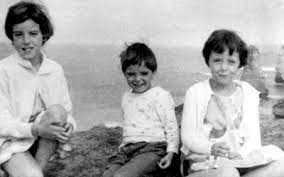The Mystery of The Beaumont Children

On January 26, 1966, three children from Adelaide, Australia, Jane (9), Arnna (7) and Grant Beaumont (4) went to Glenelg Beach for a day out. They were last seen by a witness at around 10:30 am, and were supposed to return home by 3 pm. However, when they didn't return, their parents notified the police, starting one of Australia's most enduring and mysterious missing persons cases.
The police immediately launched an extensive search for the children. Despite the efforts of hundreds of volunteers and police officers, no trace of the Beaumont children was ever found. The case remains one of Australia's most perplexing unsolved mysteries.

Over the years, many theories and leads have been pursued in the case, but none have resulted in any solid evidence or answers. Some people believe that the children were abducted and murdered, while others believe that they may have drowned accidentally and their bodies were washed out to sea.
On January 26th, Jane, her sister Arnna, and brother Grant left their house at 10 a.m. They were seen on the beach at 10:15. The siblings were supposed to return home by 12 p.m., but when their mother, Nancy, went to meet them at the bus stop, they were not there. She initially thought they had gotten caught up playing or decided to walk home, as they lived less than a mile away from the beach. However, when the children had not returned by 2:15 p.m., Nancy began to worry. She declined a friend's offer to drive her to the beach to search for them, as she wanted to be home in case they returned.

Instead, Jim arrived just before 3 p.m., home a day early from his sales trip. So he drove to Glenelg Beach to look for Jane, Arrna, and Grant Jr. Not spotting them in the crowd, he returned home, hoping they'd be there.
At 5 p.m., the Beaumonts walked to the Glenelg Police Station to report their children missing.
"I knew there was something wrong if they weren't home," Jim later recounted, per Madigan. "The thought going through my mind was that they had been taken away. I didn't think they could have been drowned because there were so many people down there."
The search for the Beaumont children, which would later become one of the most notorious crimes in Australia's history, began with a search of the family's residence by police. That night, the father of the children, Jim, joined the patrol cars searching the nearby areas of Somerton Park and Glenelg. He continued the search on his own when the patrol cars dropped him off. The following day, boats from the Sea Rescue Squadron joined the search efforts, as well as airport and train stations were alerted and roadblocks were put in place to monitor anyone coming in and out of Adelaide. The police also used loudspeakers to ask the public if they had seen the Beaumont children. The taxi drivers, who knew Jim as a former driver, also helped spread the word, and many people, including members of Jane's Brownie troop, searched the area on foot.
And, naturally, reporters flocked to the family's house, and Jim addressed them mid-morning on Jan. 28 from his back porch. "Somebody must be holding them against their will, they would otherwise have come home by now," he said. "It's a complete mystery, I can't understand it. My kids will be crying their eyes out. It's like a nightmare."

Within 24 hours of the children's disappearance, the police were receiving numerous tips and observations from the public. The bus driver on the route that the children took reported seeing them on the bus at 10:10 a.m. on January 26th, but could not confirm if they had taken the return trip. It was later discovered that the children had visited Wenzel's Bakery near the beach around noon and Jane had purchased pasties and a meat pie for their lunch using a £1 note that her mother was not aware of her having. The neighborhood postman also reported seeing the children "holding hands and laughing" on his route but could not specify if it was at 1:45 p.m. or 2:55 p.m. The following day, the postman stated that he believed it was closer to 3 p.m.
"We had one phone for the main police station, that's all we had, and people were queuing up to give statements and what have you, and we only had a sergeant and four men there," Mostyn Matters, one of the original detectives on the case, recalled to Australia's ABC News in 2018. "They were just snowed under and by the time you interviewed people and [typed] up their reports and everything, it was just one of those things, where you could only do your best. We still had our own work going on, there were still crimes being committed in Glenelg."
Amid the glut of ultimately unhelpful information, police heard from multiple witnesses who said they saw Jane, Arnna and Grant Jr. playing on the beach with a tall, thin-faced blonde man who looked to be in his 30s. They seemed to know him, or at least were willingly hanging out with him.
But that was that.
Weeks after her children vanished, Nancy told reporters, "I don't think they're alive, but I haven't lost hope, and all I want is that they come back."
In 1968, Nancy and Jim received two letters, the first telling them when and where to go if they wanted to get their children back. In the second, after the parents went to the designated place and nothing happened, the sender claimed to have seen a detective following them and decided not to go through with it.
Countless theories were put forth over the years, including one by Dutch psychic Gerard Croiset, who claimed to have had a vision of the children's fate and was flown to Australia in November 1966 by a deep-pocketed real estate developer. According to Croiset, the children had been trapped under the floor of an old brick factory that was being used as a warehouse.
With no evidence other than the psychic's claims, authorities refused to get involved. But concerned citizens raised $40,000 to get the job done and an excavation under the watchful eye of television cameras began in 1967—and found nothing.
In 1986, according to the Sydney Morning Herald, three suitcases full of newspaper clippings about the Beaumont case were found in a garbage dump, most of the pages scribbled with handwritten notes in red ink. Across an image of the widely circulated sketch of the suspect was written, "Lies—all bluff."
Only a day later, however, people who identified themselves as relatives of the elderly owner of those suitcases told police that she had simply become obsessed with the case, and after she died they threw the bags out.
Numerous alleged sightings of the kids poured in over the years, from a woman in Perth who insisted she was living next door to the children in 1966 to a former detective on the case who became convinced in 1997 that Jane Beaumont was alive and well and living in Canberrra. (Investigators confirmed it was not her.)
In November 2013, more than 46 years after a psychic sent the citizenry on a wild goose chase, part of the New Castalloy factory in the Adelaide suburb of North Plympton was excavated after two brothers alleged that the building's late owner, Harry Phipps, had them dig a pit on the property on Australia Day in 1966.
Phipps died in 2004 but was posthumously investigated starting in 2007 after his son Haydn, who also told police his father sexually abused him, claimed he saw his dad with the Beaumont children. Other family members disputed Haydn's claims.
In recent years, new technology has been used to try to solve the case, such as ground-penetrating radar, but these efforts have yet to yield any significant breakthroughs.
The Beaumont children's disappearance has captivated the Australian public for more than 50 years and continues to be one of the country's most enduring unsolved mysteries. The case remains open and active, with South Australian police stating that they will continue to investigate any new leads that come to light.
The Beaumont family has never given up hope of finding their missing children and has made repeated appeals for information. They continue to hold out hope that one day they will finally learn the truth about what happened to Jane, Arnna, and Grant.
The case is a tragic reminder of the pain and suffering that can be caused by unsolved crimes and the importance of never giving up hope for answers and justice.

 My First News Item
My First News Item My Nine News Item
My Nine News Item